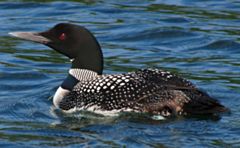Project 4810: G. Mayr, A. C. Kitchener. 2022. Oldest fossil loon documents a pronounced ecomorphological shift in the evolution of gaviiform birds. Zoological Journal of the Linnean Society. 196 (4):1431-1450.
Abstract
We describe a stem group representative of Gaviiformes (loons or divers) from the early Eocene London Clay of Walton-on-the-Naze (Essex, UK). The holotype of Nasidytes ypresianus gen. et sp. nov. is a partial skeleton including the mandible and all major limb bones. The new species is the oldest unambiguously identified loon and the most substantial Palaeogene fossil record of Gaviiformes. The mandible of Nasidytes is proportionally wider than that of extant loons and resembles that of extant coots (Fulica spp.), which indicates that the new taxon was less piscivorous than crown group Gaviiformes. Hypotarsus morphology suggests that N. ypresianus is the sister taxon of a clade including all other Cenozoic fossil loons and crown group Gaviiformes. According to its plesiomorphic leg morphology, and unlike extant loons, the new species was not a specialized pursuit predator of fishes. The evolution of advanced diving capabilities in the stem lineage of Gaviiformes is likely to have been correlated with an increased piscivory of loons, and the skeletal morphology of Nasidytes conforms to multiple independent origins of specialized piscivory and a highly aquatic ecology in the waterbird clade (Aequornithes).Read the article »
Article DOI: 10.1093/zoolinnean/zlac045
Project DOI: 10.7934/P4810, http://dx.doi.org/10.7934/P4810
| This project contains |
|---|
Download Project SDD File |
Currently Viewing:
MorphoBank Project 4810
MorphoBank Project 4810
- Creation Date:
03 August 2023 - Publication Date:
08 August 2023
Authors' Institutions ![]()
- National Museums of Scotland, Royal Museum, Edinburgh
- Senckenberg Research Institute (Forschungsinstitut Senckenberg)

